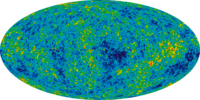
Photo from wikipedia
We apply two Bayesian hierarchical inference schemes to infer shear power spectra, shear maps and cosmological parameters from the CFHTLenS weak lensing survey - the first application of this method… Click to show full abstract
We apply two Bayesian hierarchical inference schemes to infer shear power spectra, shear maps and cosmological parameters from the CFHTLenS weak lensing survey - the first application of this method to data. In the first approach, we sample the joint posterior distribution of the shear maps and power spectra by Gibbs sampling, with minimal model assumptions. In the second approach, we sample the joint posterior of the shear maps and cosmological parameters, providing a new, accurate and principled approach to cosmological parameter inference from cosmic shear data. As a first demonstration on data we perform a 2-bin tomographic analysis to constrain cosmological parameters and investigate the possibility of photometric redshift bias in the CFHTLenS data. Under the baseline $\Lambda$CDM model we constrain $S_8 = \sigma_8(\Omega_\mathrm{m}/0.3)^{0.5} = 0.67 ^{\scriptscriptstyle+ 0.03 }_{\scriptscriptstyle- 0.03 }$ $(68\%)$, consistent with previous CFHTLenS analysis but in tension with Planck. Adding neutrino mass as a free parameter we are able to constrain $\sum m_\nu < 4.6\mathrm{eV}$ (95%) using CFHTLenS data alone. Including a linear redshift dependent photo-$z$ bias $\Delta z = p_2(z - p_1)$, we find $p_1=-0.25 ^{\scriptscriptstyle+ 0.53 }_{\scriptscriptstyle- 0.60 }$ and $p_2 = -0.15 ^{\scriptscriptstyle+ 0.17 }_{\scriptscriptstyle- 0.15 }$, and tension with Planck is only alleviated under very conservative prior assumptions. Neither the non-minimal neutrino mass or photo-$z$ bias models are significantly preferred by the CFHTLenS (2-bin tomography) data.
Journal Title: Monthly Notices of the Royal Astronomical Society
Year Published: 2017
Link to full text (if available)
Share on Social Media: Sign Up to like & get
recommendations!